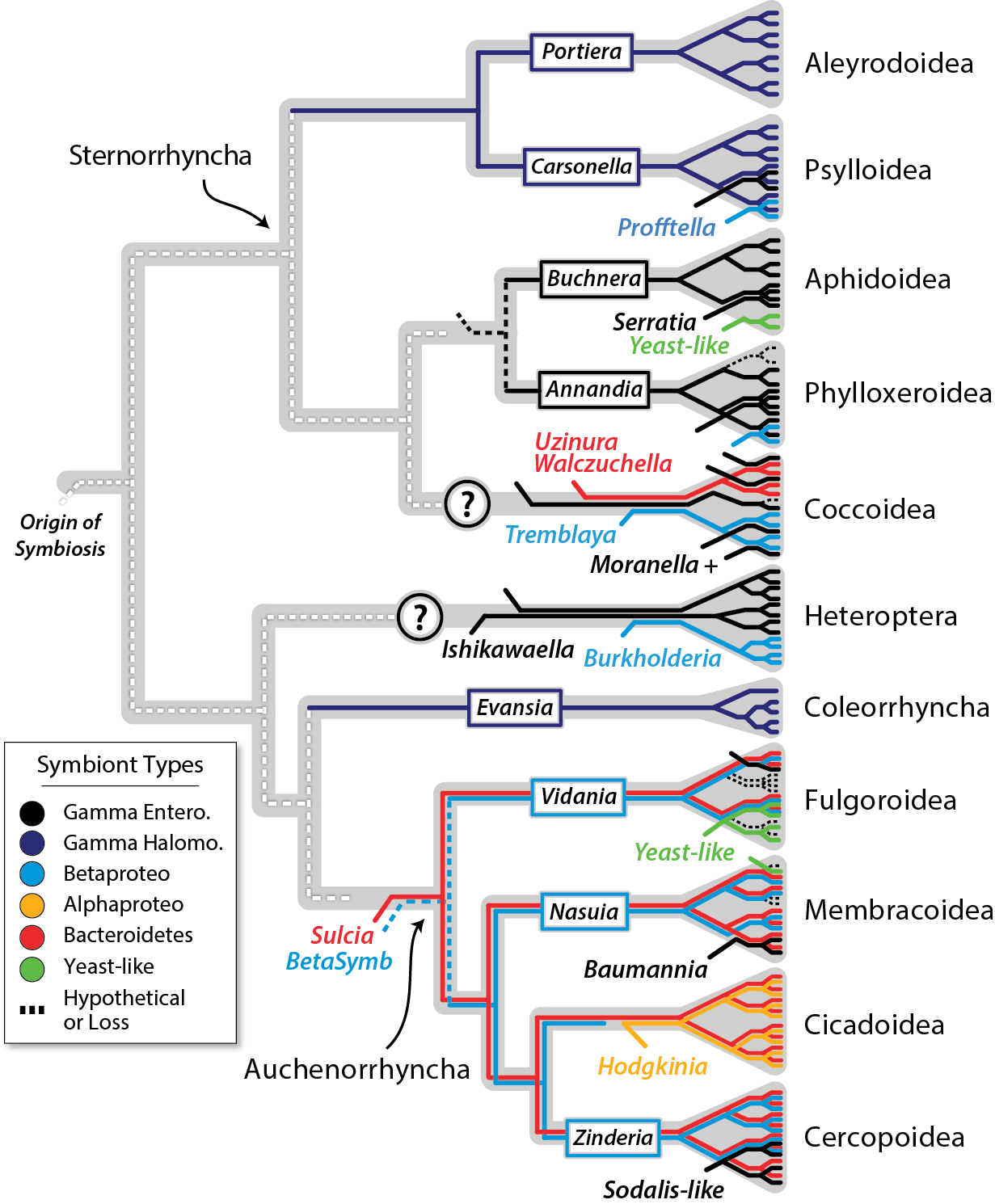Evolution of Bacterial Symbiosis
My lab seeks to understand how insects and microbial symbioses co-evolve and interact on a molecular level.
The questions we focus on are:
(a) how do insect-microbial interactions influence insect ecology and diversity;
(b) what are patterns of genomic co-evolution in ancient bacterial-insect symbioses;
and, (c) how are host and symbiont functions and metabolisms integrated on a cellular level.
We are particularly interested in leafhoppers, one of the largest plant sap-feeding groups of insects, as a model system. Leafhoppers rely on at least two obligate symbionts - generally bacteria - for nutrition absent in their plant-sap diets (e.g., phloem and xylem). These bacterial symbionts have tiny genomes that have been stripped of most essential functions for independent life. Thus, they require extensive resources from the host to perform even the most basic cellular functions.

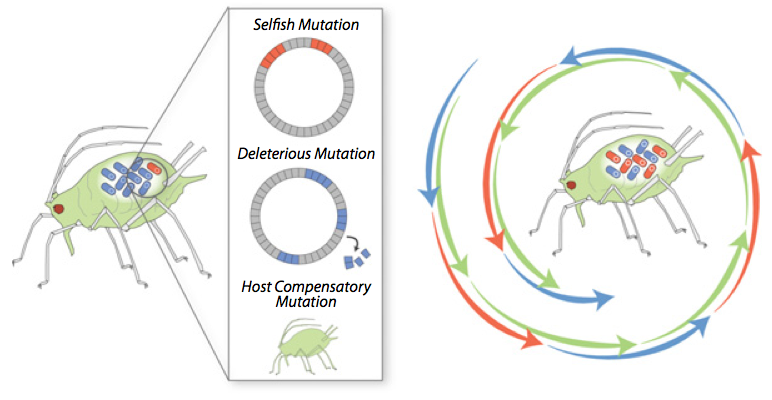
[A] Origins and co-evolution of symbioses sap-feeding insects (Auchenorrhyncha)
Overview
The associations of sap-feeding insects and bacteria are ancient, reaching back hundreds of millions of years. It is likely that symbionts contributed to the rise of the Hemiptera insect order (see below), when insects allied with bacteria to feed on vascular plants. In many hemipteran groups, including the sharpshooter leafhoppers (e.g., Cicadellinae), bacterial symbionts have been lost and replaced. The ancient nature of symbionts - and ongoing replacements - have produced a dynamic range co-evolutionary outcomes. This includes the outlandishly small 112 kb genome found in Nasuia from the host, Macrosteles quadrilineatus (Cicadellidae: Deltocephalinae).
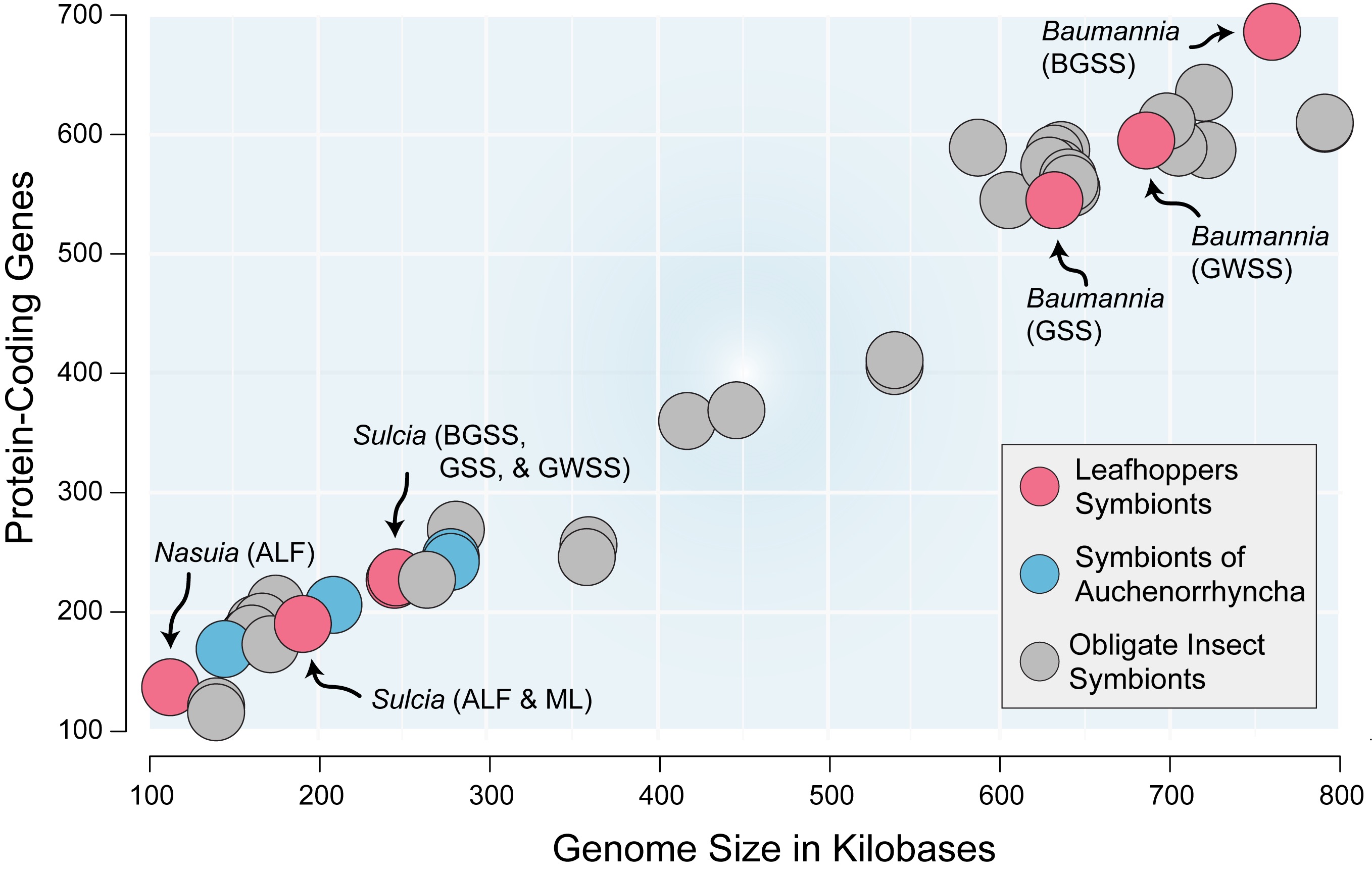
Leafhoppers (Cicadellidae)
To date, most of our work has focused on leafhopper species (Cicadellidae) in an effort to develop a model system for more advanced questions. The phloem-feeding host species, Macrosteles quadrilineatus (Cicadellidae: Deltocephalinae: ALF) harbors two bacterial symbionts with the smallest known genomes of any system: Sulcia (190 kb) and Nasuia (112 kb; Betaproteobacteria). Both symbionts are widespread in leafhoppers. They perfectly complement each other to provide the 10 EAAs required by their hosts. However, both have limited, but distinct genomic capabilities in basic functions including energy metabolism, replication, and gene expression. Thus, they require discrete cellular and genetic inputs from the host, which is the basis of our current research projects.The co-primary symbiont in sharpshooters, Baumannia that replaced Nasuia, has an incredibly dynamic genome ranging vastly in cellular capabilities and over 100 kb in size (see graph above). Symbiont replacements may have also facilitated evolutionary transitions to novel trophic niches such as xylem feeding in sharpshooters. These systems provide the unique opportunity to understand how symbiont and host genomes adapt and decay during the co-evolution of their symbiotic relationships with hosts.

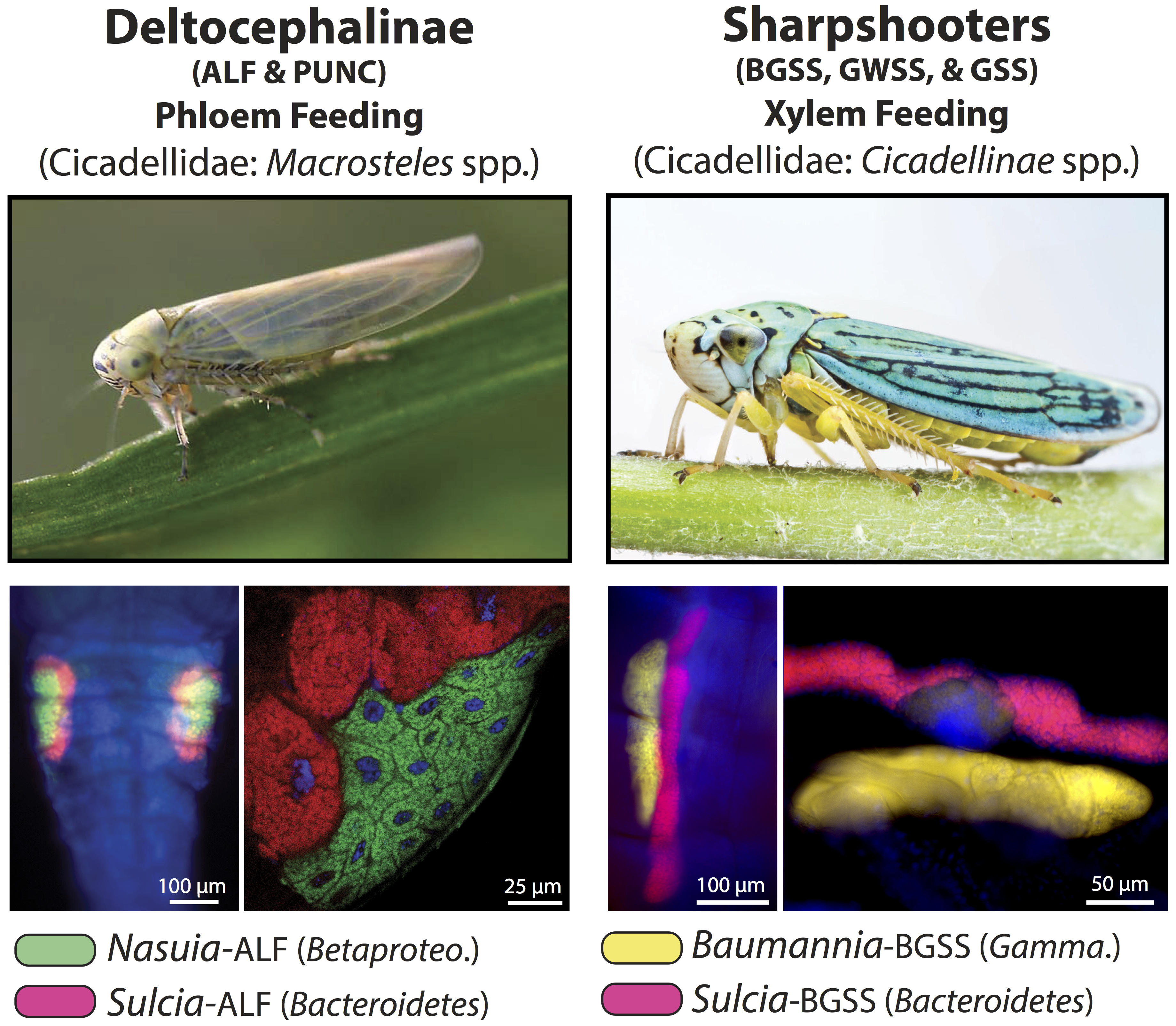
Treehoppers (Membracidae)
Recently we completed a genomic project investigating the dual-symbionts of the treehopper, Entylia carinata (ENCA). Genomic analyses show that ENCA harbors Sulcia and Nasuia, which have larger genomes than in leafhoppers (Sulcia = 218 kb and Nasuia = 144 kb). Nasuia exhibits few unique gene losses, suggesting the common ancestor to leafhoppers and treehoppers was already highly reduced. Sulcia lost the ability to completely synthesize branched-chain EAAs, which is unique to any auchenorrhynch symbiosis. These results show that extensive gene losses are specific to leafhoppers (e.g., ALF and Hawaiian Nesophrosyne). Symbionts likely have increased genetic support from their hosts.
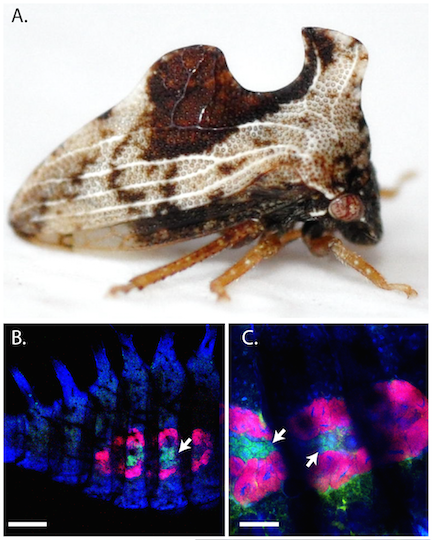
Planthoppers (Cixiidae)
The completely sequenced symbiont genomes of the planthopper, Cixiidae: Oliarus spp. (OLIH) revealed that Although the Auchenorrhyncha split early during its diversification (>250 MYA) into the Fulgoroidea (planthoppers) and Cicadomorpha (leafhoppers and cicadas), phylogenomics reveal that many descendent species share two ancient symbiont lineages, Sulcia and a Betaproteobacteria (e.g., described as Nasuia in leafhoppers, Vidania in planthoppers, and Zinderia in spittlebugs). In each case, bacterial partners collaboratively provide their hosts with the 10 essential amino acids that all animals require. However, the completely nutritional provisioning of these ancient partners is rearranged relative to all other auchenorrhynchan hosts investigated to date. The cixiids also acquired a third symbiont, Purcelliella to help support its two more ancient ones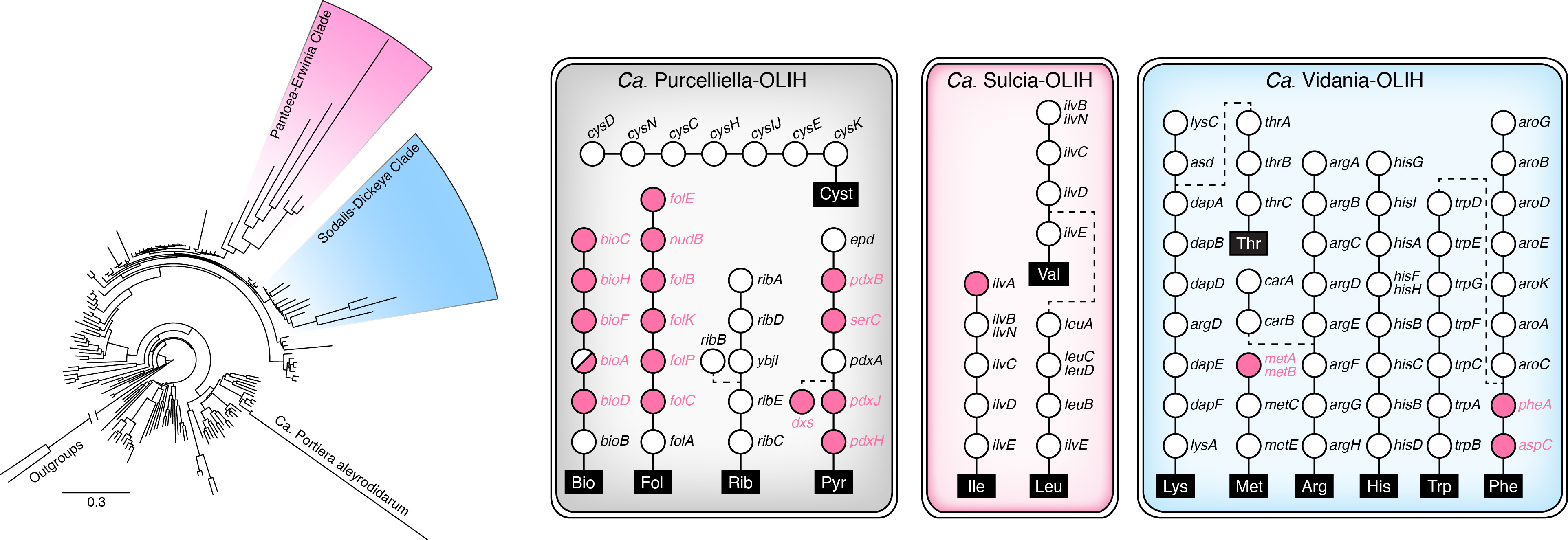
[B] Functional integration of symbiotic partners
One of the major challenges in establishing a long-term symbiosis is integrating the functions of symbiotic partners. This is particularly the case when hosts rely on multiple partners that have incomplete genetic capabilities. Different bacterial species likely require tailored cellular and metabolic inputs from the host. However, it is unclear how hosts adapt to their multiple partners and whether they evolve distinct genetic mechanisms to support them. To address this question, my lab has developed multi-omic experiments and techniques to understand how ALF manages its two obligate symbionts, Sulcia and Nasuia.This work is currently underway!

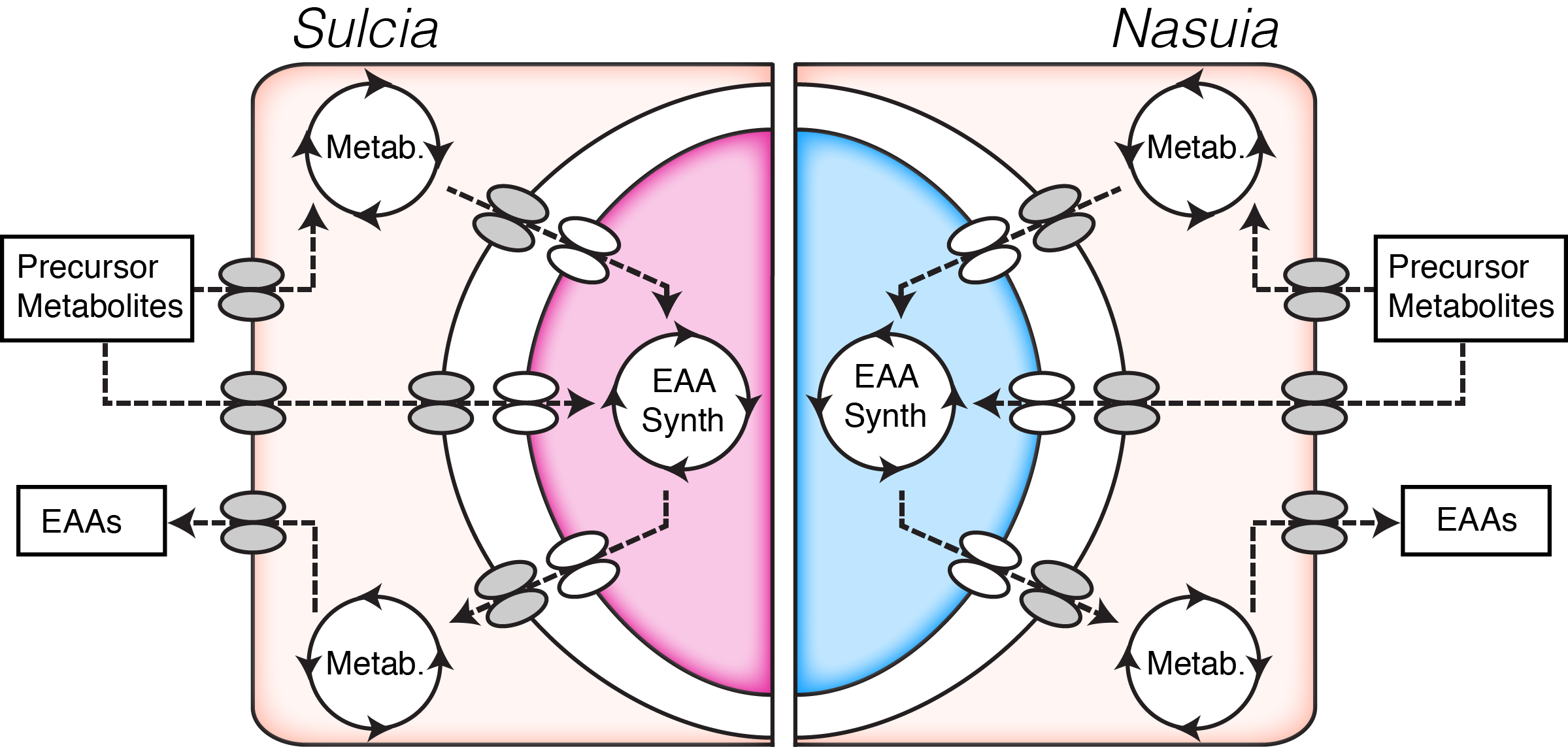
[C] The role of nutritional symbioses in adaptive species radiation
Animal-bacteria symbioses have shaped diversity by providing hosts with novel adaptive traits. While selection operates to maintain mutualistic traits in both hosts and their symbionts, bacteria experience genome degradation and selfish evolutionary tendencies. These processes likely shape host speciation and adaptation by reinforcing reproductive isolation, limiting environmental tolerance, and restricting host dietary range. However, the role of these mechanisms in influencing host-symbiont co-adaptions and diversification are poorly understood. To address this question, we are developing a project that uses the endemic Hawaiian leafhopper, Nesophrosyne, adaptive radiation to understand how symbioses shape speciation and adaptation. The Hawaiian Islands offer a natural evolutionary experiment to test such questions due to their diverse, time-stratified, and replicated habitat formation. A comparative multi-omics approach will interrogate symbiont and host genomes to detect shifts in selection on co-adapted genetic pathways. This project will determine the genetic mechanisms that underlie and shape adaptive species radiations.This work is currently underway!
Recent Projects
Comparative genomics of a quadripartite symbiosis in a planthopper host reveals the origins and rearranged nutritional responsibilities of anciently diverged bacterial lineages
Genome sequencing and phylogenomics of the three obligate symbionts in a planthopper. Results support the 300 MYO relationship between the Auchenorrhyncha, Sulcia, and Nasuia - one of the most ancient symbioses known. Remarkably, in contrast to the Cicadomorpha, nutritional synthesis responsibilities are rearranged between the cixiid symbionts.
Hosts go to great lengths to evolve differential support mechanisms of their distinct symbionts. Some of these mechanisms include horizontal acquisition of novel genes from bacteria to the insect genome, and the reassignment of mitochondrial support genes to the symbiont care.
Evolution of host support for two ancient bacterial symbionts with differentially degraded genomes in a leafhopper host
Genome-wide transcriptional dynamics in the companion bacterial symbionts of the glassy-winged sharpshooter (Cicadellidae: Homalodisca vitripennis) reveal differential gene expression in bacteria occupying multiple host organs
Recent work identifying the potential roles of distinct obligate symbionts - Sulcia and Baumannia - that are housed in separate host tissues in the Glassy Winged Sharpshooter, Homalodisca vitripennis
Comparative genomics of the dual-obligate symbionts from the treehopper, Entylia carinata (Hemiptera: Membracidae), provide insight into the origins and evolution of an ancient symbiosis.
Comparative genomics project investigating the capabilities and origins of the obligate symbionts - Sulcia and Nasuia - in the treehopper host, Entylia carinata (Membracidae: ENCA)
Lineage-specific patterns of genome deterioration in obligate symbionts
Project aimed at understanding how symbiont replacements evolve in sharpshooter leafhoppers. Sharpshooters have an ancient, although relatively young symbiont, Baumannia
Advantages and perils of symbioses
Review project outlining the advantages and limitations of obligate symbioses in insect evolution
Tiniest Known Genomes!
We are always interested in exploring the diversity of co-evolutionary outcomes in different insect groups. These are forever revealing the smallest known genomes.
